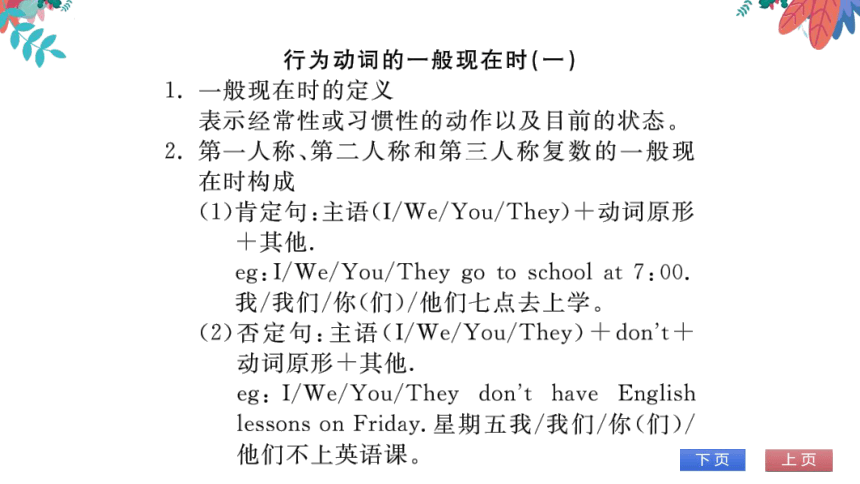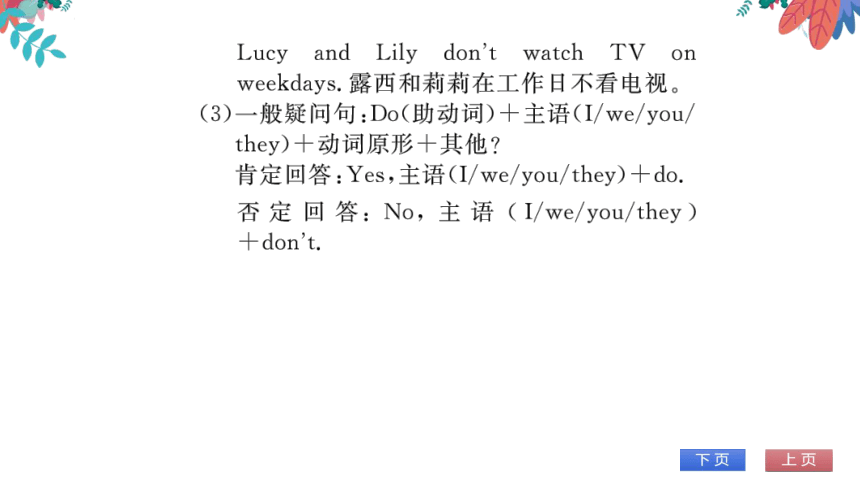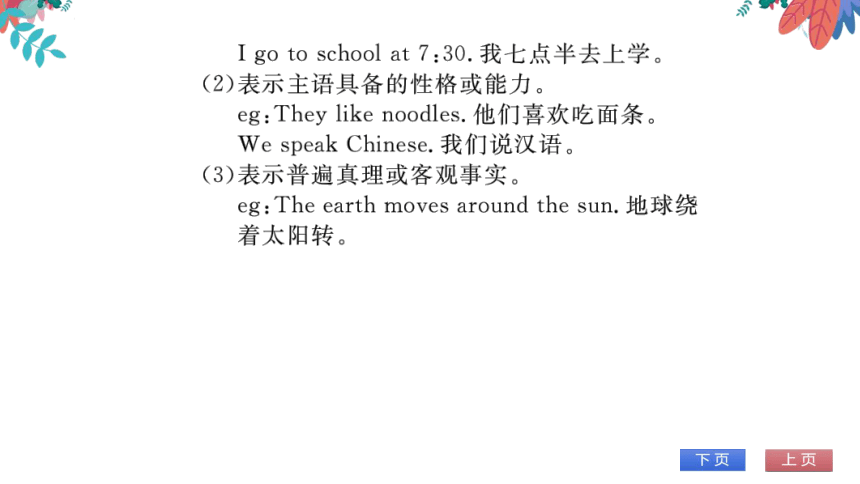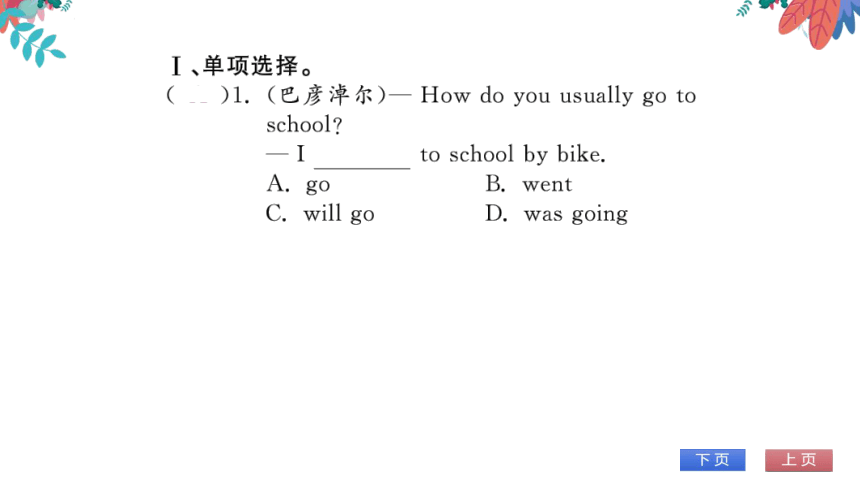【外研版】七上 Module5 My school day 模块语法活学巧练 习题课件
文档属性
| 名称 | 【外研版】七上 Module5 My school day 模块语法活学巧练 习题课件 |  | |
| 格式 | pptx | ||
| 文件大小 | 2.3MB | ||
| 资源类型 | 试卷 | ||
| 版本资源 | 外研版 | ||
| 科目 | 英语 | ||
| 更新时间 | 2021-12-07 09:24:32 | ||
图片预览







文档简介
(共14张PPT)
行为动词的一般现在时(一)
般现在时的定义
表示经常性或习惯性的动作以及目前的状态
2.第一人称、第二人称和第三人称复数的一般现
在时构成
(1)肯定句:主语(I/We/You/They)+动词原形
其他
eg: I/We/You/ They go to school at 7: 00
我/我们/你(们)/他们七点去上学
(2)否定句:主语(IWe/You/They)+dont
动词原形+其他
eg: I/We/You/ they dont have english
lessons on friday.星期五我/我们/你(们)
他们不上英语课。
Lucy and lily dont watch Tv on
weekdays.露西和莉莉在工作日不看电视
(3)一般疑问句:Do(助动词)十主语(I/we/you
they)十动词原形+其他
肯定回答:Yes,主语(I/we/you/they)+d
do
eg:- Do they go to bed at10:00 他们十
点睡觉吗
Yes, they do.是的,他们是
Do you like history 你(们)喜欢历史吗
NO,I/ we don’t.不,我(们)不喜欢。
3.一般现在时的用法
(1)表示经常性或习惯性的动作
eg: We have lunch at school.我们在学校吃
午饭
I go to school at7:30.我七点半去上学。
(2)表示主语具备的性格或能力
eg: They like noodles.他们喜欢吃面条
We speak Chinese.我们说汉语。
(3)表示普遍真理或客观事实
eg: The earth moves around the sun.地球绕
着太阳转
单项选择。
(A)1.(巴彦淖尔)— How do you usually go to
school
to school by bike.
A. go
went
C. will go
D. was going
(A)2
you have to wear a uniform(t
服) at school
A. Do
B. Does
re
d. Be
(A)3
What do you often do at weekends
i often
my grandparents.
A.ⅴisit
B. visited
C. have visited
D. will visit
行为动词的一般现在时(一)
般现在时的定义
表示经常性或习惯性的动作以及目前的状态
2.第一人称、第二人称和第三人称复数的一般现
在时构成
(1)肯定句:主语(I/We/You/They)+动词原形
其他
eg: I/We/You/ They go to school at 7: 00
我/我们/你(们)/他们七点去上学
(2)否定句:主语(IWe/You/They)+dont
动词原形+其他
eg: I/We/You/ they dont have english
lessons on friday.星期五我/我们/你(们)
他们不上英语课。
Lucy and lily dont watch Tv on
weekdays.露西和莉莉在工作日不看电视
(3)一般疑问句:Do(助动词)十主语(I/we/you
they)十动词原形+其他
肯定回答:Yes,主语(I/we/you/they)+d
do
eg:- Do they go to bed at10:00 他们十
点睡觉吗
Yes, they do.是的,他们是
Do you like history 你(们)喜欢历史吗
NO,I/ we don’t.不,我(们)不喜欢。
3.一般现在时的用法
(1)表示经常性或习惯性的动作
eg: We have lunch at school.我们在学校吃
午饭
I go to school at7:30.我七点半去上学。
(2)表示主语具备的性格或能力
eg: They like noodles.他们喜欢吃面条
We speak Chinese.我们说汉语。
(3)表示普遍真理或客观事实
eg: The earth moves around the sun.地球绕
着太阳转
单项选择。
(A)1.(巴彦淖尔)— How do you usually go to
school
to school by bike.
A. go
went
C. will go
D. was going
(A)2
you have to wear a uniform(t
服) at school
A. Do
B. Does
re
d. Be
(A)3
What do you often do at weekends
i often
my grandparents.
A.ⅴisit
B. visited
C. have visited
D. will visit
同课章节目录
- Starte
- Module 1 My teacher and my friends
- Module 2 My English lesson
- Module 3 My English book
- Module 4 My everyday life
- Module 1 My classmates
- Unit 1 Nice to meet you.
- Unit 2 I'm Wang Lingling and I'm thirteen years ol
- Unit 3 Language in use.
- Module 2 My family
- Unit 1 Is this your mum?
- Unit 2 These are my parents.
- Unit 3 Language in use.
- Module 3 My school
- Unit 1 There are thirty students in my class.
- Unit 2 The library is on the left of the playgroun
- Unit 3 Language in use.
- Module 4 Healthy food
- Unit 1 We've got lots of apples.
- Unit 2 Is your food and drink healthy?
- Unit 3 Language in use.
- Module 5 My school day
- Unit 1 I love history.
- Unit 2 We start work at nine o'clock.
- Unit 3 Language in use.
- Revision module A
- Module 6 A trip to the zoo
- Unit 1 Does it eat meat?
- Unit 2 The tiger lives in Asia.
- Unit 3 Language in use.
- Module 7 Computers
- Unit 1 How do I write my homework on the computer?
- Unit 2 When do you use a computer?
- Unit 3 Language in use.
- Module 8 Choosing presents
- Unit 1 I always like birthday parties.
- Unit 2 She often goes to concerts.
- Unit 3 Language in use.
- Module 9 People and places
- Unit 1 We're enjoying the school trip a lot.
- Unit 2 They're waiting for buses or trains.
- Unit 3 Language in use.
- Module 10 Spring Festival
- Unit 1 Are you getting ready for Spring Festival?
- Unit 2 My mother's cleaning our houses and sweepin
- Unit 3 Language in use.
- Revision module B
